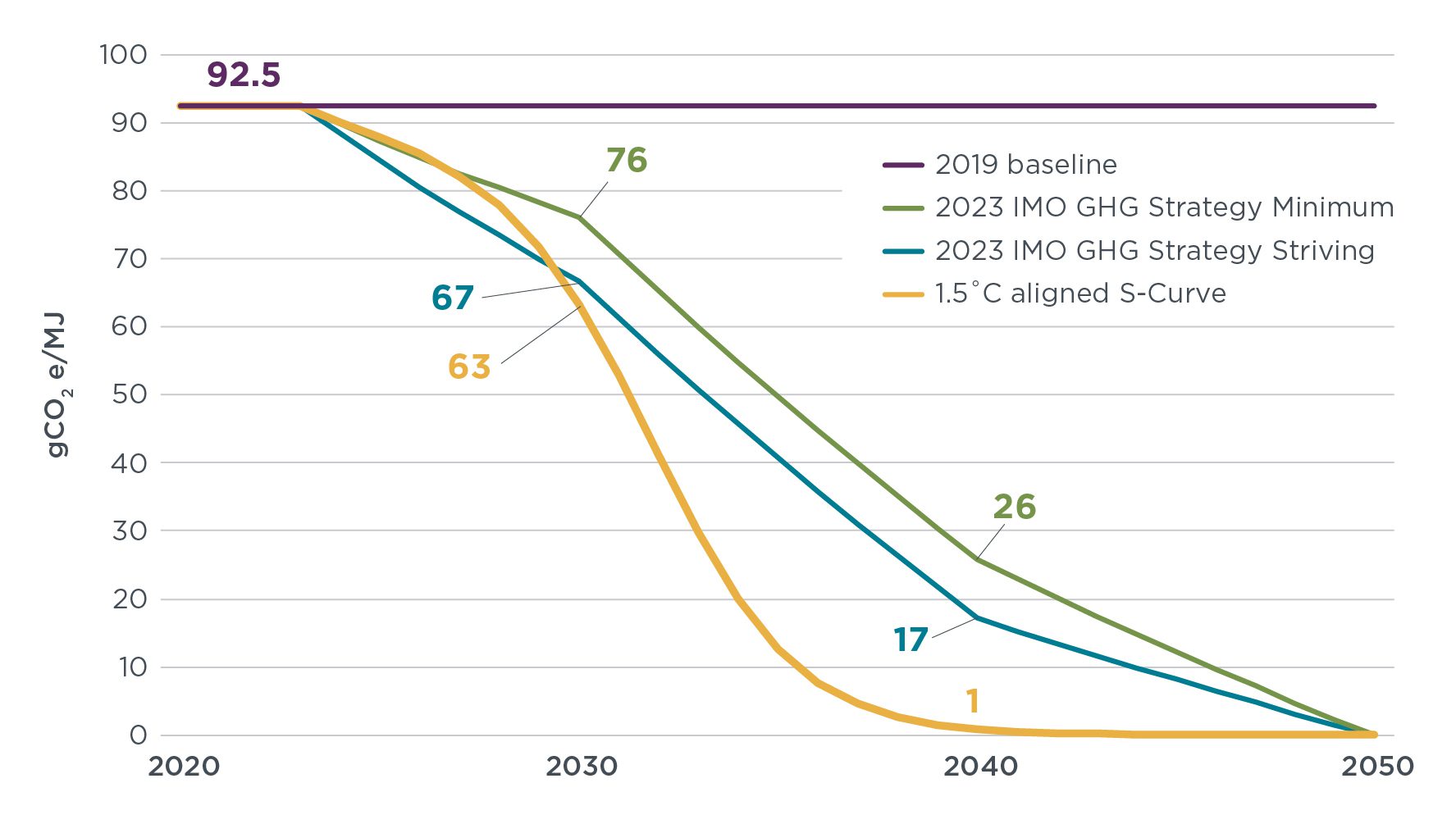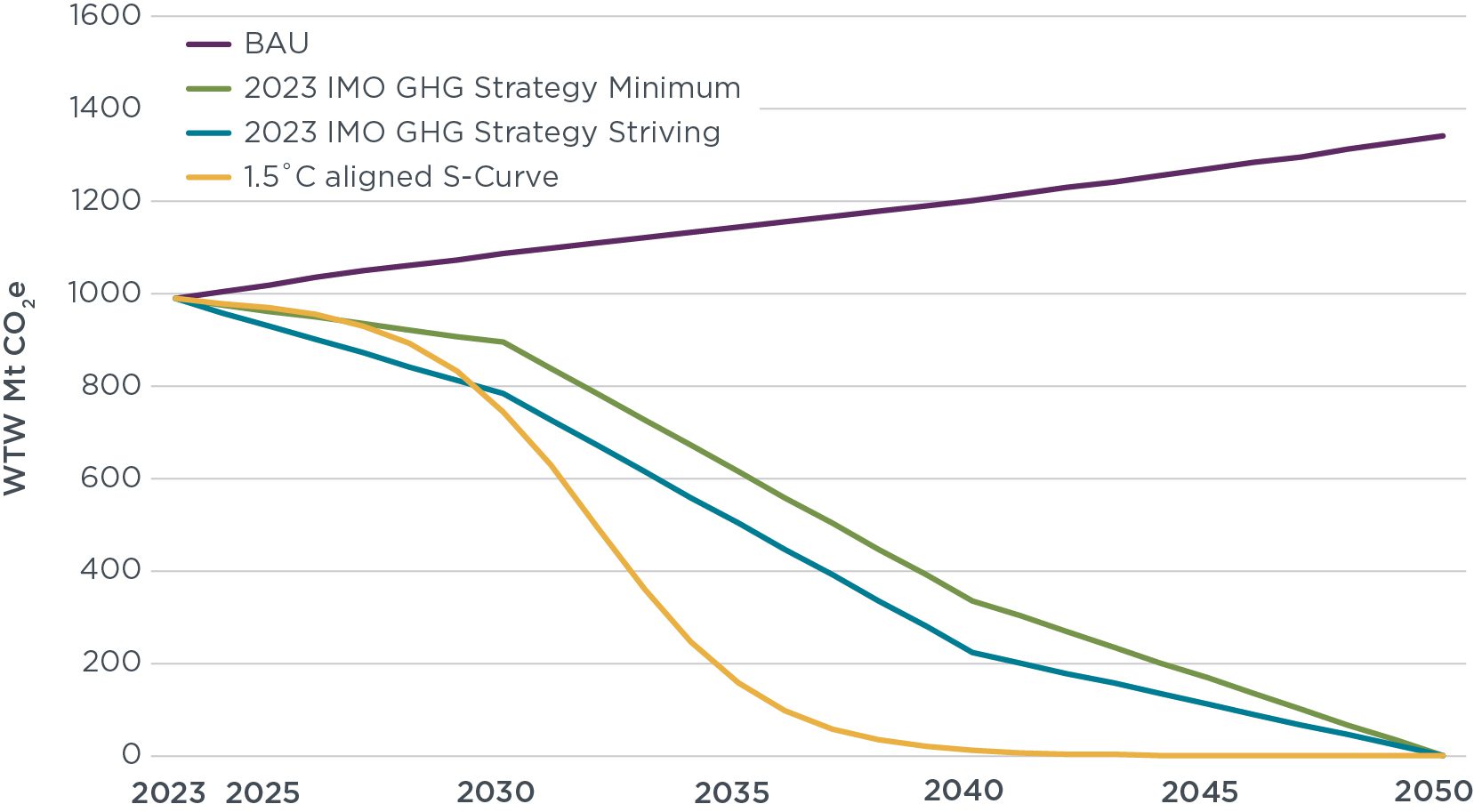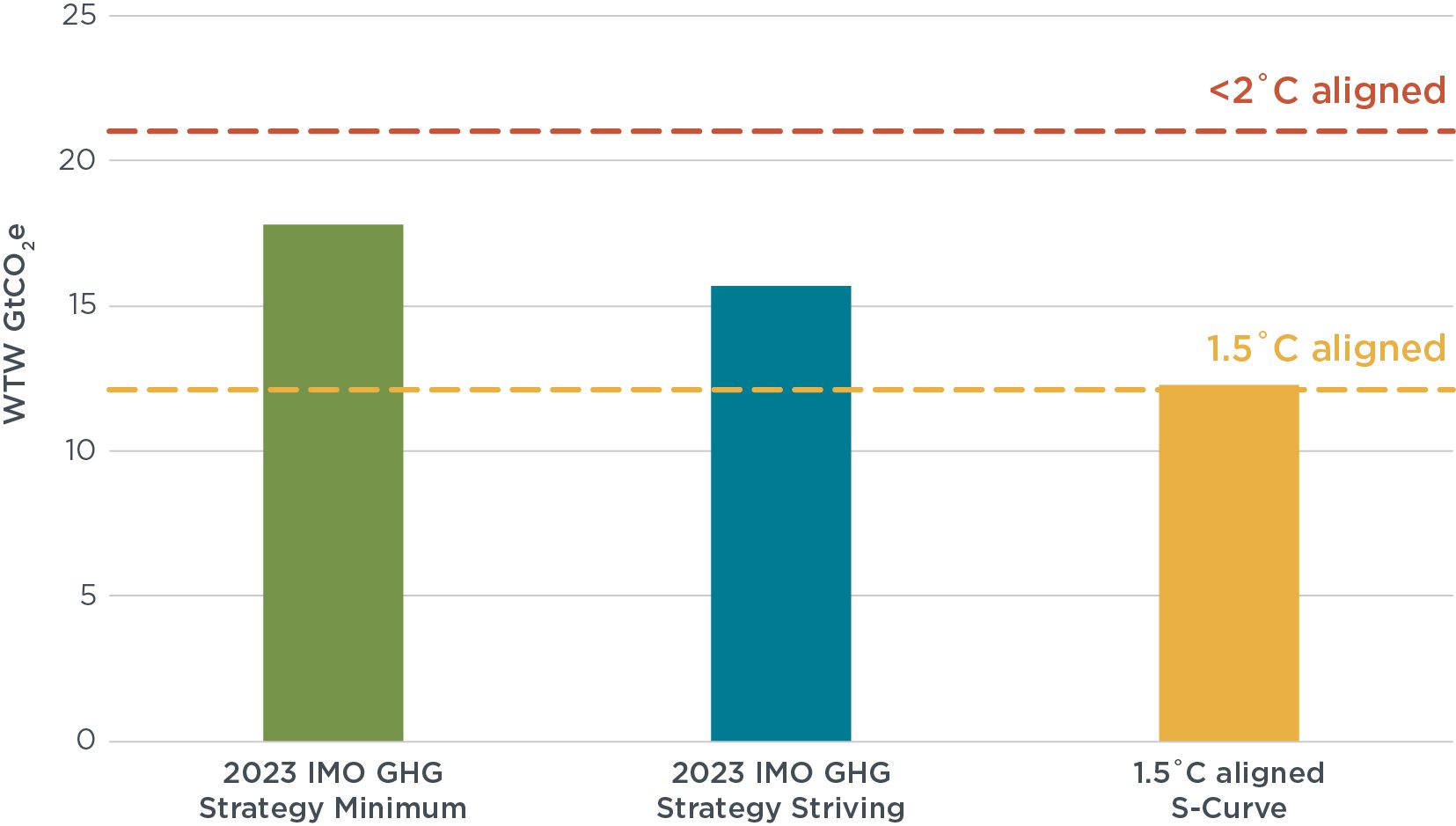IMO’s newly revised GHG strategy: What it means for shipping and the Paris Agreement
Blog
Aligning the IMO’s Greenhouse Gas Fuel Standard with its GHG strategy and the Paris Agreement
In July 2023, the International Maritime Organization (IMO) adopted a revised strategy that calls for reducing greenhouse gas (GHG) emissions from ships to net-zero by or around 2050. While the revised strategy is not legally binding, the measures used to implement it can be, and in many ways it’s the stringency of these measures that will ultimately determine shipping’s contribution to future global warming.
Earlier this week, our colleague highlighted the need for measures that limit emissions from ships measured on a life-cycle basis, the well-to-wake (WTW) emissions. With this blog post, we show how one proposed measure, the GHG Fuel Standard (GFS), can be used to reduce emissions in line with the IMO’s revised 2023 strategy or with a pathway consistent with limiting warming to 1.5°C.
The GFS being designed now will require ships to use fuels that emit fewer WTW GHG emissions until there is a complete transition to all zero-emission fuels. This GFS is meant to encourage the adoption of new fuels including renewable e-fuels (hydrogen, ammonia, and methanol) and sustainable biofuels; by setting limits on the GHG emissions intensity of fuels, it will drive investments in production capacity and infrastructure for new fuels. One effective design of the GFS would identify the date by which the WTW GHG intensity of marine fuels is to reach zero and include interim GHG intensity targets (at regular intervals) to keep the sector on a steady course toward its final goal. Here we use ICCT’s new Polaris model to estimate the WTW GHG intensity reductions that would be needed to achieve net-zero by 2050 in a pathway consistent with the 2023 IMO GHG strategy. Polaris is a global maritime emissions projection model that reports tank-to-wake (TTW) and WTW emissions as carbon dioxide equivalents (CO2e) based on the 100-year or 20-year global warming potentials of CO2, methane, nitrous oxide, and black carbon (we exclude black carbon in this particular analysis because it’s not accounted for in the guidelines on life-cycle GHG intensity of marine fuels).
Figure 1 shows the straight-line GFS trajectory that satisfies the emissions reduction targets in the 2023 IMO GHG strategy and an S-curve trajectory that would stay below the cumulative emissions limit for 1.5°C estimated here. The GFS trajectories were determined based on the business as usual (BAU) predicted energy use from the Polaris model and target emissions in the 2023 IMO strategy and 1.5°C aligned pathways (using 100-year global warming potentials, GWP100). For 2030, the 2023 IMO strategy set a goal of at least a 20% reduction in absolute GHG emissions compared to 2008 levels, and “striving for” a 30% reduction; for 2040, the GHG reduction goals are at least 70% and striving for 80% below 2008 levels. Predicted energy use from Polaris goes from 10.7 EJ in 2023 to 14.5 EJ in 2050, and we estimated the baseline GHG intensity of marine fuels at 92.5 gCO2e/MJ from shipping’s fuel mix in 2019 using ICCT’s Systematic Assessment of Vessel Emissions (SAVE) model and excluding black carbon emissions.

Figure 1. Well-to-wake GHG intensities of marine fuels required to align the IMO GHG Fuel Standard (GFS) with IMO’s 2023 GHG strategy and a 1.5 °C-compatible emissions trajectory.
As Figure 1 illustrates, to achieve the minimum IMO targets, the GHG intensity of marine fuels will have to reduce by 18% to 76 gCO2e/MJ by 2030 and by 72% to 26 gCO2e/MJ in 2040 compared to the 2019 baseline. For the “striving” scenario, reductions in 2030 and 2040 will have to be 28% to 67 gCO2e and 81% to 17 gCO2e/MJ, respectively. A 1.5°C-aligned pathway requires 32% reductions in WTW GHG intensity in 2030 to 63 gCO2e/MJ and 99% in 2040 to nearly zero GHG emissions. All pathways require 100% reductions by 2050. Following the GHG intensities in Figure 1 would result in the absolute emissions reduction pathways presented in Figure 2.

Figure 2. Absolute well-to-wake GHG emissions trajectories under each scenario.
Table 1 specifies the GHG intensity limits needed to follow the absolute emissions reduction pathways in Figure 2. This table can be used by policymakers as they develop the GFS.
Table 1. Well-to-wake GHG intensities (gCO2e/MJ) and reductions in well-to-wake GHG intensities of marine fuels from the 2019 fossil fuel baseline needed to align the GFS with different emissions trajectories.
| Scenario | Metric | 2027 | 2030 | 2035 | 2040 | 2045 | 2050 |
| Minimum IMO target | GHG intensity | 82 | 76 | 50 | 26 | 12 | 0 |
| Reduction from 2019 baseline | 11% | 18% | 46% | 72% | 87% | 100% | |
| “Striving” IMO target | GHG intensity | 77 | 67 | 41 | 17 | 8 | 0 |
| Reduction from 2019 baseline | 17% | 28% | 56% | 81% | 91% | 100% | |
| 1.5°C-compatible | GHG intensity | 82 | 63 | 13 | 1 | 0 | 0 |
| Reduction from 2019 baseline | 11% | 32% | 86% | 99% | 100% | 100% |
The cumulative WTW CO2e emissions compared to “well-below” 2°C (interpreted by us as keeping warming to not more than 1.7°C) and 1.5°C limits are presented in Figure 3. Achieving the minimum or striving IMO targets is consistent with limiting warming to well-below 2°C and the S-curve is consistent with 1.5°C.

Figure 3. Cumulative well-to-wake GHG emissions from 2020-2050 implied by each scenario.
The 2023 GHG strategy also includes a target for the uptake of zero or near-zero GHG emission fuels and/or energy sources that should represent at least 5% (striving for 10%) of the energy used by international shipping by 2030. Achieving even the minimum 5% energy target in 2030 would require 0.6 EJ of zero/near-zero fuels. To put this target into perspective, 0.6 EJ represents around 14% of global biofuel demand in 2022 (~4.3 EJ), whereas shipping (~11 EJ/year) represents about 2.5% of global energy demand (~442 EJ/year). When considered in the context of the limited availability of sustainable advanced biofuels for use in shipping, this underlines the importance of scaling up e-fuels to achieve IMO’s target.
The stronger the GFS targets, the greater the demand for zero/near-zero GHG emission fuels, the fewer GHGs emitted by the sector, and the greater the likelihood that shipping aligns with both IMO’s GHG strategy and the Paris Agreement. The next opportunity for IMO delegates to contribute to the design of the GFS is at the meeting of the 16th Intersessional Working Group on GHG emissions from ships in March 2024.
Author
Related Publications
Assesses the potential of a variety of liquid biofuels to reduce shipping greenhouse gas emissions on a well-to-wake, life-cycle basis relative to distillate marine fuels.


